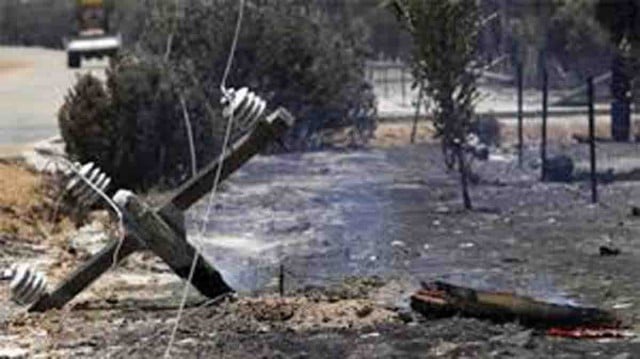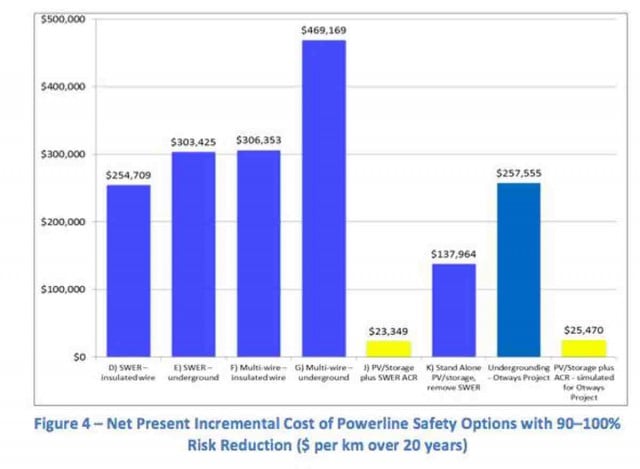 By Giles Parkinson, reneweconomy.com.au
By Giles Parkinson, reneweconomy.com.au
The latest bushfire season in Australia has highlighted the risks associated with Australia’s elongated grid: Not only are the wooden poles and wires that connect homes and communities to centralised power stations vulnerable to fire, wind and storms, they are also responsible for causing much of the damage when uninsulated wires are blown over on high risk days and create devastating fires.
The experience in Western Australia and Tasmania in recent weeks has highlighted how vulnerable centralised power systems are to bushfires, although the impacts this year pale into comparison with the devastating impacts of the Black Saturday fires in Victoria in 2009.
Authorities are responding with proposals to put some power lines underground, and provide insulation for others. But a new study suggests that they are overlooking a much cheaper option – installing solar and battery storage in at risk areas can virtually eliminate the risk at just one tenth of the price.
As authorities are learning in WA, Queensland and elsewhere, distributed generation and micro-grids can undercut the costs of an expansive grid and centralised generation by a large margin, and offer both energy and personal security.
The study by Michael Williamson, a master of science student at the University of Loughborough, underlines why the combination of solar and storage should be looked at in terms of value, rather than just cost. Already networks are finding that installing battery storage can cut grid costs by one third – but this study shows how much battery storage and localised generation can save when the grid needs a major upgrade.
The Williamson study looks specifically at the experience of the devastating Black Saturday bushfires in Victoria in 2009, which caused the loss of 173 lives and $5.2 billion in economic damage, and the follow-up recommendations.
Investigations into that fire suggested 92 per cent of the losses were caused by vegetation igniting from uninsulated power lines being blown into trees or on to the ground.
Combined with the Ash Wednesday fires of 1983, Williamson estimates that more than $5.5 billion of damage, and 190 deaths, can be directly blamed on falling power lines in a single generation in a single state.
Williamson has crunched the numbers of the various alternatives considered and put into place by Victorian authorities, including putting lines underground, installing Rapid Earth Fault Current Limiting (REFCL) devices on some lines and Auto Circuit Reclosers (ACRs) on others.
 The Victorian authorities also considered putting whole communities off grid, with solar and storage, or of cutting off power on high risk days. But these options were dismissed – because of the estimated cost of going totally off-grid, and because cutting off power because rural homes need power for the internet and other essential services in cases of emergency.
The Victorian authorities also considered putting whole communities off grid, with solar and storage, or of cutting off power on high risk days. But these options were dismissed – because of the estimated cost of going totally off-grid, and because cutting off power because rural homes need power for the internet and other essential services in cases of emergency.
Williamson proposes a compromise solution, by installing enough solar and storage to allow rural homes to be cut off from the grid and have enough power only during days of high bush fire risk and total fire bans – which amounts to as much as 25 days in a year or 4 to 5 days in a row.
This means that homeowners get power, and the grid is not made completely redundant, and there are additional private and public benefits from having more solar and storage on the grid.
And because less solar and less storage is needed than being totally off grid, it is much cheaper – around $23,000 per rural home compared to the $60,000 estimated in 2011.
Based on a comparison with powerline undergrounding, the report concludes that solar PV and storage could achieve the same risk reduction as undergrounding at just 10 per cent of the ‘net present cost.’ And it says this approach is transferable to other fire-prone regions such as New South Wales, South Australia, Western Australia and Southern California.
Not only have solar and storage costs come down a lot, but for Williamson’s solution, they can also be tailored to need.
Rather being designed to operate for 365 days a year, including in winter, these arrays would only need to be sized for the 10-25 days a year considered extreme fire risk – or total fire bans – which usually coincides with hot summer days and good sunshine. In recent years, this has been for up to five consecutive days.
Williamson’s proposal is that on high risk fire days, the power lines are shut off, and the rural homes at the end of the line depend on solar and storage. The proposal takes advantage of good sunshine, the high sunk costs of the grid – which can be used for the remainder of their operating life – and the private and public benefits of having solar and storage on the network.
Williamson’s modeling is based on the needs of a two-person household, which he estimates at 4.6kW of rooftop solar and 14kWh of lithium-ion storage (two 7kWh units).
His calculations do not include the economies and efficencies that could be gained from carefully managing demand during the period, or the potential for future falls in battery storage costs (which many think will be at least 50 per cent in coming years).
‘The ACR offers risk reduction of approximately 50 per cent but the addition of PV and storage reduces this residual risk to practically zero, while offsetting the drawback of time off supply. And it can be done at one tenth of the net present cost of conduction insulation or under grounding,’ the report says.
‘The analysis demonstrates that the use of solar PV and energy storage is an economically and technically feasible means of preventing power-line initiated bushfires in Victoria.’
Williamson’s findings are significant when considering the scale of the task facing Victoria, and the increased fire risk from climate change in Victoria and many other regions.
The government has so far allocated $A200 million for the powerline replacement fund over 10 years, which will fund the replacement of about 1,000km of single wire earth return (SWER) lines, the ones considered most vulnerable.
But in all, there are a total of 28,000kms of SWER lines in the state, including 12,000km of uninsulated power lines that authorities consider to be ‘priority targets.’ There are a further 50,000 km of multi-wire 22kV lines in rural areas of Victoria, that will need insulation or under grounding to remove risk.
Williamson says this leaves a substantial amount of infrastructure which needs to be made safe, at a cost of many billions of dollars But his approach is transferable to other fire-prone regions such as New South Wales, South Australia and Southern California.
Interestingly, the WA grid operator Western Power is considering the use of solar and storage micro-grids as a cheaper option to repairing and upgrading power lines damaged in the recent fires in the south-west of the state.
And in Tasmania, the vulnerability of the grid to bushfire risk to power lines has been highlighted by instances in that state which have put four hydro-electric plants off line at various times, adding to the problems being created by record-low storage levels caused by the drought, and the so far unexplained loss of the under-sea grid connection to the mainland.



